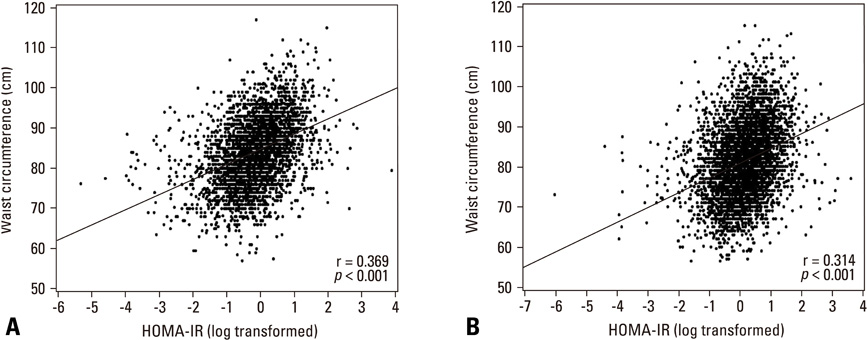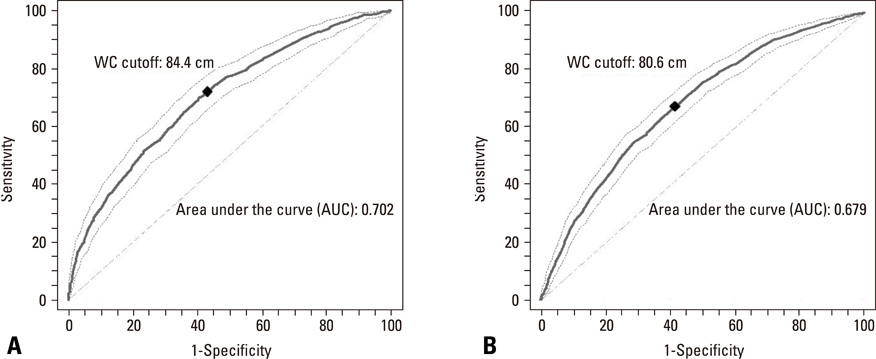Yonsei Med J.
2010 Jul;51(4):511-518. 10.3349/ymj.2010.51.4.511.
Optimal Waist Circumference Cutoff Value Reflecting Insulin Resistance as a Diagnostic Criterion of Metabolic Syndrome in a Nondiabetic Korean Population Aged 40 Years and Over: The Chungju Metabolic Disease Cohort (CMC) Study
- Affiliations
-
- 1Department of Preventive Medicine, College of Medicine, The Catholic University of Korea, Seoul, Korea. leewc@catholic.ac.kr
- 2Division of Endocrinology and Metabolism, Department of Internal Medicine, College of Medicine, The Catholic University of Korea, Seoul, Korea.
- 3The Catholic Institute of Ubiquitous Healthcare, The Catholic University of Korea, Seoul, Korea.
- KMID: 1805187
- DOI: http://doi.org/10.3349/ymj.2010.51.4.511
Abstract
- PURPOSE
We aimed at determining the cutoff value of waist circumference with respect to its ability to reflect insulin resistance in a Korean population.
MATERIALS AND METHODS
A total of 8,817 subjects aged 40 years and over were analyzed. Insulin resistant individuals were defined as those who had the highest quartile value of the homeostasis model assessment of insulin resistance (HOMA-IR) in a non-diabetic population. Receiver operating characteristic (ROC) curve analysis and multiple logistic regression analysis were applied.
RESULTS
The cutoff value of waist circumference reflecting insulin resistance from the ROC analysis was 84.4 cm for men and 80.6 cm for women. Sensitivity and specificity were 70.0% and 54.2% in men and 71.1% and 59.3% in women, respectively. After being controlled for other covariates, the odds ratio for the risk of insulin resistance using < 70 cm of waist circumference as a reference increased significantly in the category of 85.0-89.9 cm for men and 80.0-84.9 cm for women. In addition, statistically significant associations were consistently observed over the category of 85.0-89.9 cm for men and 80.0-84.9 cm for women.
CONCLUSION
The optimal cutoff value for waist circumference reflecting insulin resistance is considered to be 85 cm for men and 80 cm for women, suggesting that the Asian criterion of abdominal obesity (90 cm for men and 80 cm for women) as a component of metabolic syndrome (MetS) might not be applicable for middle-aged to older men in Korea.
Figure
Reference
-
1. Bloomgarden ZT. Definitions of the insulin resistance syndrome: the 1st World Congress on the Insulin Resistance Syndrome. Diabetes Care. 2004. 27:824–830.2. Expert Panel on Detection, Evaluation, and Treatment of High Blood cholesterol in Adults. Executive Summary of The Third Report of The National Cholesterol Education Program (NCEP) Expert Panel on Detection, Evaluation, And Treatment of High Blood Cholesterol In Adults (Adult Treatment Panel III). JAMA. 2001. 285:2486–2497.3. Alberti KG, Zimmet PZ. Definition, diagnosis and classification of diabetes mellitus and its complications. Part 1: diagnosis and classification of diabetes mellitus provisional report of a WHO consultation. Diabet Med. 1998. 15:539–553.
Article4. Alberti KG, Eckel RH, Grundy SM, Zimmet PZ, Cleeman JI, Donato KA, et al. Harmonizing the metabolic syndrome: a joint interim statement of the International Diabetes Federation Task Force on Epidemiology and Prevention; National Heart, Lung, and Blood Institute; American Heart Association; World Heart Federation; International Atherosclerosis Society; and International Association for the Study of Obesity. Circulation. 2009. 120:1640–1645.5. Alberti KG, Zimmet P, Shaw J. Metabolic syndrome--a new world-wide definition. A Consensus Statement from the International Diabetes Federation. Diabet Med. 2006. 23:469–480.
Article6. Han JH, Park HS, Kim SM, Lee SY, Kim DJ, Choi WH. Visceral adipose tissue as a predictor for metabolic risk factors in the Korean population. Diabet Med. 2008. 25:106–110.
Article7. Kim JA, Choi CJ, Yum KS. Cut-off values of visceral fat area and waist circumference: diagnostic criteria for abdominal obesity in a Korean population. J Korean Med Sci. 2006. 21:1048–1053.8. Lee SY, Park HS, Kim DJ, Han JH, Kim SM, Cho GJ, et al. Appropriate waist circumference cutoff points for central obesity in Korean adults. Diabetes Res Clin Pract. 2007. 75:72–80.
Article9. Howard G, O'Leary DH, Zaccaro D, Haffner S, Rewers M, Hamman R, et al. Insulin sensitivity and atherosclerosis. The Insulin Resistance Atherosclerosis Study (IRAS) Investigators. Circulation. 1996. 93:1809–1817.10. Haffner SM, Miettinen H. Insulin resistance implications for type II diabetes mellitus and coronary heart disease. Am J Med. 1997. 103:152–162.11. DeFronzo RA. Insulin resistance: a multifaceted syndrome responsible for NIDDM, obesity, hypertension, dyslipidaemia and atherosclerosis. Neth J Med. 1997. 50:191–197.
Article12. Reaven GM. The metabolic syndrome: requiescat in pace. Clin Chem. 2005. 51:931–938.13. Garg A. Regional adiposity and insulin resistance. J Clin Endocrinol Metab. 2004. 89:4206–4210.
Article14. Lebovitz HE, Banerji MA. Point: visceral adiposity is causally related to insulin resistance. Diabetes Care. 2005. 28:2322–2325.15. Park SH, Lee WY, Rhee EJ, Jeon WK, Kim BI, Ryu SH, et al. Relative risks of the metabolic syndrome according to the degree of insulin resistance in apparently healthy Korean adults. Clin Sci (Lond). 2005. 108:553–559.
Article16. Poirier P, Lemieux I, Mauriège P, Dewailly E, Blanchet C, Bergeron J, et al. Impact of waist circumference on the relationship between blood pressure and insulin: the Quebec Health Survey. Hypertension. 2005. 45:363–367.
Article17. Bergman RN, Kim SP, Catalano KJ, Hsu IR, Chiu JD, Kabir M, et al. Why visceral fat is bad: mechanisms of the metabolic syndrome. Obesity (Silver Spring). 2006. 14:Suppl 1. 16S–19S.
Article18. Hotamisligil GS. Inflammation and metabolic disorders. Nature. 2006. 444:860–867.
Article19. Kwon HS, Park YM, Lee HJ, Lee JH, Choi YH, Ko SH, et al. Prevalence and clinical characteristics of the metabolic syndrome in middle-aged Korean adults. Korean J Intern Med. 2005. 20:310–316.
Article20. Park YM, Kwon HS, Lim SY, Lee JH, Kim SR, Yoon KH, et al. Clustering characteristics of risk variables of metabolic Syndrome in Korean rural populations. J Korean Diabetes Assoc. 2006. 30:177–189.
Article21. Balkau B, Charles MA. Comment on the provisional report from the WHO consultation. European Group for the Study of Insulin Resistance (EGIR). Diabet Med. 1999. 16:442–443.22. Resnick HE, Bergman RN, Henderson JA, Nez-Henderson P, Howard BV. Utility of a surrogate measure of insulin resistance in American Indians: the Strong Heart Study. Ethn Dis. 2002. 12:523–529.23. Expert Committee on the Diagnosis and Classification of Diabetes Mellitus. Report of the expert committee on the diagnosis and classification of diabetes mellitus. Diabetes Care. 2003. 26:Suppl 1. S5–S20.24. Matthews DR, Hosker JP, Rudenski AS, Naylor BA, Treacher DF, Turner RC. Homeostasis model assessment: insulin resistance and beta-cell function from fasting plasma glucose and insulin concentrations in man. Diabetologia. 1985. 28:412–419.
Article25. The IDF consensus worldwide definition of the metabolic syndrome. International Diabetes Federation (IDF). Accessed 1 September 2009. Available from http://www.idf.org/webdata/docs/MetS_def_update2006.pdf.26. Iwao N, Iwao S, Muller DC, Koda M, Ando F, Shimokata H, et al. Differences in the relationship between lipid CHD risk factors and body composition in Caucasians and Japanese. Int J Obes (Lond). 2005. 29:228–235.
Article27. Zhou BF. Cooperative Meta-Analysis Group of the Working Group on Obesity in China. Predictive values of body mass index and waist circumference for risk factors of certain related diseases in Chinese adults--study on optimal cut-off points of body mass index and waist circumference in Chinese adults. Biomed Environ Sci. 2002. 15:83–96.28. Aekplakorn W, Kosulwat V, Suriyawongpaisal P. Obesity indices and cardiovascular risk factors in Thai adults. Int J Obes (Lond). 2006. 30:1782–1790.
Article29. Ohkubo T, Kikuya M, Asayama K, Imai Y. A proposal for the cutoff point of waist circumference for the diagnosis of metabolic syndrome in the Japanese population. Diabetes Care. 2006. 29:1986–1987.30. Kenneth JR, Sander G, Timothy LL. Modern epidemiology. 2008. Philadelphia: Lippincott Williams & Wilkins.31. Kohrt WM, Kirwan JP, Staten MA, Bourey RE, King DS, Holloszy JO. Insulin resistance in aging is related to abdominal obesity. Diabetes. 1993. 42:273–281.32. Ryan AS, Nicklas BJ, Elahi D. A cross-sectional study on body composition and energy expenditure in women athletes during aging. Am J Physiol. 1996. 271:E916–E921.
Article33. Racette SB, Evans EM, Weiss EP, Hagberg JM, Holloszy JO. Abdominal adiposity is a stronger predictor of insulin resistance than fitness among 50-95 year olds. Diabetes Care. 2006. 29:673–678.34. Korea Center for Disease Control and Prevention. The Third Korea National Health and Nutrition Examination Survey (KNHANES III), 2005. 2007.35. Kuo CS, Hwu CM, Chiang SC, Hsiao LC, Weih MJ, Kao WY, et al. Waist circumference predicts insulin resistance in offspring of diabetic patients. Diabetes Nutr Metab. 2002. 15:101–108.36. Meshkani R, Taghikhani M, Larijani B, Khatami S, Khoshbin E, Adeli K. The relationship between homeostasis model assessment and cardiovascular risk factors in Iranian subjects with normal fasting glucose and normal glucose tolerance. Clin Chim Acta. 2006. 371:169–175.
Article37. Wannamethee SG, Shaper AG, Morris RW, Whincup PH. Measures of adiposity in the identification of metabolic abnormalities in elderly men. Am J Clin Nutr. 2005. 81:1313–1321.
Article38. Snehalatha C, Viswanathan V, Ramachandran A. Cutoff values for normal anthropometric variables in asian Indian adults. Diabetes Care. 2003. 26:1380–1384.
Article39. Bonora E, Kiechl S, Willeit J, Oberhollenzer F, Egger G, Meigs JB, et al. Insulin resistance as estimated by homeostasis model assessment predicts incident symptomatic cardiovascular disease in caucasian subjects from the general population: the Bruneck study. Diabetes Care. 2007. 30:318–324.
Article40. Hanley AJ, Williams K, Stern MP, Haffner SM. Homeostasis model assessment of insulin resistance in relation to the incidence of cardiovascular disease: the San Antonio Heart Study. Diabetes Care. 2002. 25:1177–1184.
Article
- Full Text Links
- Actions
-
Cited
- CITED
-
- Close
- Share
- Similar articles
-
- Optimal Waist Circumference Cutoff Values for Metabolic Syndrome Diagnostic Criteria in a Korean Rural Population
- Factors Associated with Insulin Resistance in a Middle-Aged Non-Obese Rural Population: The Chungju Metabolic Disease Cohort (CMC) Study
- Gender Differences in Diagnostic Values of Visceral Fat Area and Waist Circumference for Predicting Metabolic Syndrome in Koreans
- Clustering Characteristics of Risk Variables of Metabolic Syndrome in Korean Rural Populations
- Metabolic Syndrome Defined by International Diabetes Federation (IDF) or National Cholesterol Education Program (NCEP) and Insulin Resistance



